真核生物转录调节
真核基因不同水平上的表达调控
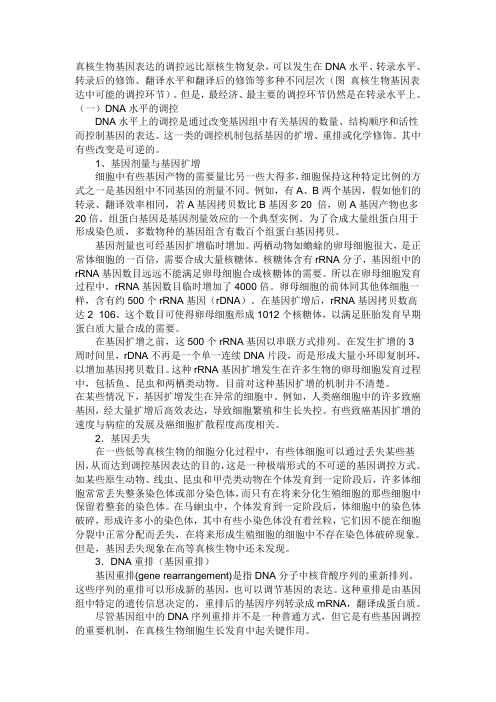
真核生物基因表达的调控远比原核生物复杂,可以发生在DNA水平、转录水平、转录后的修饰、翻译水平和翻译后的修饰等多种不同层次(图真核生物基因表达中可能的调控环节)。
但是,最经济、最主要的调控环节仍然是在转录水平上。
(一)DNA水平的调控DNA水平上的调控是通过改变基因组中有关基因的数量、结构顺序和活性而控制基因的表达。
这一类的调控机制包括基因的扩增、重排或化学修饰。
其中有些改变是可逆的。
1、基因剂量与基因扩增细胞中有些基因产物的需要量比另一些大得多,细胞保持这种特定比例的方式之一是基因组中不同基因的剂量不同。
例如,有A、B两个基因,假如他们的转录、翻译效率相同,若A基因拷贝数比B基因多20 倍,则A基因产物也多20倍。
组蛋白基因是基因剂量效应的一个典型实例。
为了合成大量组蛋白用于形成染色质,多数物种的基因组含有数百个组蛋白基因拷贝。
基因剂量也可经基因扩增临时增加。
两栖动物如蟾蜍的卵母细胞很大,是正常体细胞的一百倍,需要合成大量核糖体。
核糖体含有rRNA分子,基因组中的rRNA基因数目远远不能满足卵母细胞合成核糖体的需要。
所以在卵母细胞发育过程中,rRNA基因数目临时增加了4000倍。
卵母细胞的前体同其他体细胞一样,含有约500个rRNA基因(rDNA)。
在基因扩增后,rRNA基因拷贝数高达2×106。
这个数目可使得卵母细胞形成1012个核糖体,以满足胚胎发育早期蛋白质大量合成的需要。
在基因扩增之前,这500个rRNA基因以串联方式排列。
在发生扩增的3周时间里,rDNA不再是一个单一连续DNA片段,而是形成大量小环即复制环,以增加基因拷贝数目。
这种rRNA基因扩增发生在许多生物的卵母细胞发育过程中,包括鱼、昆虫和两栖类动物。
目前对这种基因扩增的机制并不清楚。
在某些情况下,基因扩增发生在异常的细胞中。
例如,人类癌细胞中的许多致癌基因,经大量扩增后高效表达,导致细胞繁殖和生长失控。
有些致癌基因扩增的速度与病症的发展及癌细胞扩散程度高度相关。
真核生物转录水平的调控机制
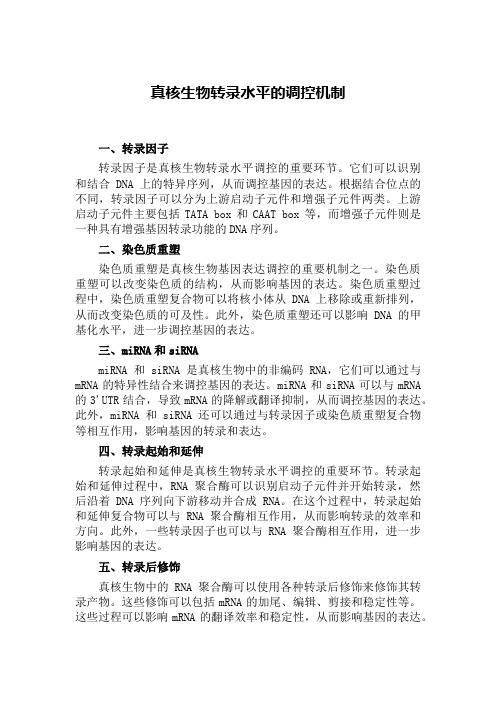
真核生物转录水平的调控机制一、转录因子转录因子是真核生物转录水平调控的重要环节。
它们可以识别和结合DNA上的特异序列,从而调控基因的表达。
根据结合位点的不同,转录因子可以分为上游启动子元件和增强子元件两类。
上游启动子元件主要包括TATA box和CAAT box等,而增强子元件则是一种具有增强基因转录功能的DNA序列。
二、染色质重塑染色质重塑是真核生物基因表达调控的重要机制之一。
染色质重塑可以改变染色质的结构,从而影响基因的表达。
染色质重塑过程中,染色质重塑复合物可以将核小体从DNA上移除或重新排列,从而改变染色质的可及性。
此外,染色质重塑还可以影响DNA的甲基化水平,进一步调控基因的表达。
三、miRNA和siRNAmiRNA和siRNA是真核生物中的非编码RNA,它们可以通过与mRNA的特异性结合来调控基因的表达。
miRNA和siRNA可以与mRNA 的3'UTR结合,导致mRNA的降解或翻译抑制,从而调控基因的表达。
此外,miRNA和siRNA还可以通过与转录因子或染色质重塑复合物等相互作用,影响基因的转录和表达。
四、转录起始和延伸转录起始和延伸是真核生物转录水平调控的重要环节。
转录起始和延伸过程中,RNA聚合酶可以识别启动子元件并开始转录,然后沿着DNA序列向下游移动并合成RNA。
在这个过程中,转录起始和延伸复合物可以与RNA聚合酶相互作用,从而影响转录的效率和方向。
此外,一些转录因子也可以与RNA聚合酶相互作用,进一步影响基因的表达。
五、转录后修饰真核生物中的RNA聚合酶可以使用各种转录后修饰来修饰其转录产物。
这些修饰可以包括mRNA的加尾、编辑、剪接和稳定性等。
这些过程可以影响mRNA的翻译效率和稳定性,从而影响基因的表达。
此外,一些蛋白质也可以通过磷酸化、乙酰化或甲基化等修饰来影响基因的表达。
六、细胞周期与细胞分化细胞周期和细胞分化是真核生物细胞生命活动中的重要过程,也是转录水平调控的重要方面。
真核基因转录的负调控机理
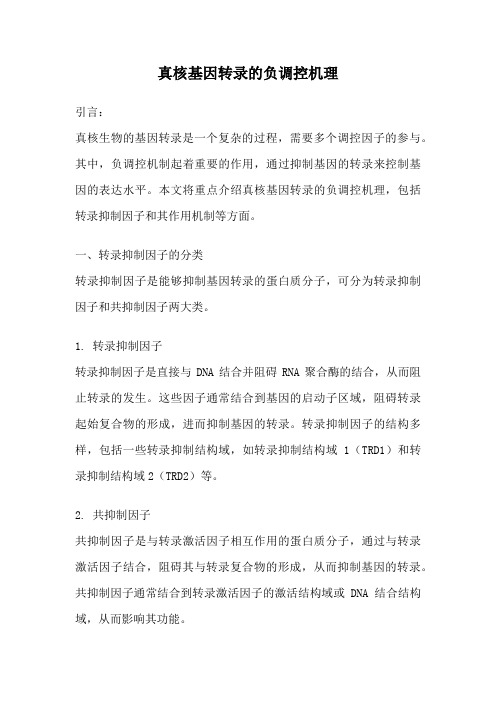
真核基因转录的负调控机理引言:真核生物的基因转录是一个复杂的过程,需要多个调控因子的参与。
其中,负调控机制起着重要的作用,通过抑制基因的转录来控制基因的表达水平。
本文将重点介绍真核基因转录的负调控机理,包括转录抑制因子和其作用机制等方面。
一、转录抑制因子的分类转录抑制因子是能够抑制基因转录的蛋白质分子,可分为转录抑制因子和共抑制因子两大类。
1. 转录抑制因子转录抑制因子是直接与DNA结合并阻碍RNA聚合酶的结合,从而阻止转录的发生。
这些因子通常结合到基因的启动子区域,阻碍转录起始复合物的形成,进而抑制基因的转录。
转录抑制因子的结构多样,包括一些转录抑制结构域,如转录抑制结构域1(TRD1)和转录抑制结构域2(TRD2)等。
2. 共抑制因子共抑制因子是与转录激活因子相互作用的蛋白质分子,通过与转录激活因子结合,阻碍其与转录复合物的形成,从而抑制基因的转录。
共抑制因子通常结合到转录激活因子的激活结构域或DNA结合结构域,从而影响其功能。
二、转录抑制因子的作用机制转录抑制因子通过多种机制实现对基因转录的负调控。
以下是几种常见的转录抑制机制:1. 空间阻隔转录抑制因子能够通过占位作用来阻隔转录激活因子与DNA结合。
在基因的启动子区域,转录抑制因子结合到DNA上,形成一个物理屏障,妨碍转录激活因子的结合。
这样一来,转录激活因子无法与转录复合物结合,导致基因的转录被阻止。
2. 修饰酶活性转录抑制因子还可以通过修饰酶活性来抑制基因的转录。
一些转录抑制因子可以直接与转录激活因子结合,并改变其修饰酶活性,从而影响转录复合物的形成。
例如,转录抑制因子可以激活组蛋白去乙酰化酶(HDAC),使其去乙酰化染色质,导致基因的沉默。
3. 转录复合物的解聚转录抑制因子还可以通过解聚转录复合物来抑制基因的转录。
转录复合物是由多个蛋白质组成的复合物,包括转录激活因子、RNA聚合酶和其他辅助因子。
转录抑制因子能够与转录复合物中的某些成分结合,改变其构象,导致复合物的解聚,从而抑制基因的转录。
细菌和真核生物转录机制的差异

细菌和真核生物转录机制的差异
1不同的转录机制
细菌和真核生物的转录机制存在一定的差异。
这些差异主要体现在以下几个方面:
1.1启动子
首先,启动子是转录反应开始的地方,其作用是连接RNA聚合酶与DNA模板上。
细菌只有一种RNA聚合酶,它能识别相对简单的DNA 启动子。
而真核生物有三类不同的RNA聚合酶,它们能够识别不同的DNA启动子。
1.2转录调节
其次,细菌的转录调节主要依赖启动子及其上游的启动子元件,而真核生物的调节除了启动子以外,还受到基因间まゝ数距离,和内部及外部环境因素的影响。
1.3转录加工
最后,细菌转录后不会经过加工就会被进行翻译,而真核生物经过mRNA加工后再被翻译,包括5'修饰(5'cap)、流式处理(polyA tail)、剪切(splicing)、转录本结构调节(RNA stability)等。
总之,细菌和真核生物的转录机制的主要差异体现在启动子的多样性、转录调节的复杂性及转录加工的必要性上。
(武汉大学)分子19.真核生物的转录调控

(武汉大学)分子19.真核生物的转录调控●本章概要●真原核生物基因调控的相同点●基本原理一致●信号均来自环境●激活因子和抑制因子●协同结合——募集调控、变构调控●最常见的调控步骤是转录起始●真原核生物基因调控的不同点●真核生物的mRNA剪接是重要的调控点●真核生物比原核生物有更加精细的转录机器●更多调控蛋白和调控序列多个调控蛋白控制一个基因●调控蛋白的作用更复杂●结合位点距转录起始位点更远●promoter 启动子基因转录系统结合的区域●regulator binding site 调控蛋白结合位点单个结合区域●regulatory sequence 调控序列包含一个基因所有调控蛋白结合位点的DNA片段●一个特定基因的调控蛋白结合位点数目增加●涉及核小体及其修饰修饰后可以改变基因可接近性●enhancer 增强子在多细胞生物中,延伸至距启动子(上游或下游)数千个核苷酸处的一组结合位点由数十个调控蛋白结合位点组成●不同的增强子与不同调控蛋白结合应答不同的信号●控制同一基因在不同时间和位置的表达●DNA弯曲:在远距离调控起到重要作用●转录调控的保守机制●所有真核生物基因调控的基本特性相同●转录机器、核小体结构、核小体修饰类似●酵母是最适于进行遗传学和生物化学研究的生物被用于探究有关激活因子和抑制因子作用机制的信息●activator激活因子类似且具有普遍性●酵母激活因子可以在哺乳动物细胞中激活转录●其作用通过reporter gene报告基因检测●作用方式与最简单的细菌非常相似●抑制因子有所不同●gene silencing 基因沉默核小体、DNA 修饰物被招募到基因组特定区域关闭基因的表达●转录激活因子DNA结合与激活功能的分离●两个功能域二者之间有柔性连接●activation domain 激活结构域没有确定结构,据氨基酸组成划分●酸性激活域●谷氨酰胺富集区●脯氨酸富集区●DNA-binding domain DNA结合结构域●种类繁多●homeodomain 同型结构域典型的螺旋- 转- 螺旋,一个螺旋插入DNA的大沟,另一个与DNA 骨架发生接触●含锌DNA 结合域含有锌指蛋白和锌簇域锌:保持 DNA结合域结构稳定多个锌指连续存在:增加识别序列的长度和结合的亲和力●亮氨酸拉链结构域(basic zipper 碱性拉链)含有二聚化区和DNA结合区二聚化区:通过适当间隔的亮氨酸残基相互作用形成包含碱性氨基酸残基●螺旋-环-螺旋基序(basic HLH protein 碱性螺旋-环-螺旋基序)与亮氨酸拉链结构相似包含碱性氨基酸残基●DNA识别原理与原核生物相似●原核生物一个螺旋(识别螺旋)插入DNA 大沟相契合识别特殊的碱基对另一个螺旋与DNA 骨架接触使识别螺旋正确定位,并增强结合●大多数利用螺旋-转-螺旋基序结合DNA●大多数以二聚体的形式结合DNA●真核生物●细节上有差异,识别DNA的原理类似●除了同源二聚体,一些调控蛋白形成heterodimer异源二聚体识别DNA,增加了可以特异结合的DNA的范围●域交换实验证明Gal4 的DNA 结合域与激活域分离的实验,创建杂合基因●Gal4能激活酿酒酵母半乳糖基因GAL1的转录与GAL1 上游4 个位点结合有半乳糖时,使GAL1 转录效率提高1000 倍●实验步骤●(a.1) 完整的Gal4:能正常激活报告基因●(a.2) 仅激活结合域:报告基因关闭,不能成功激活转录●(b.1) 仅激活LexA的结合域:也不能被激活●(b.2) (创造的融合蛋白)表达Gal4激活域和LexA的结合域:报告基因被成功激活●酵母双杂交——探究A、B蛋白是否相互作用●(对照1:仅B蛋白与转录激活域)B蛋白与某转录活化子的激活域融合●(对照2:仅A蛋白与DNA结合域)A蛋白与该转录活化子的DNA结合域融合●若AB能相互作用,就会把DNA结合域与激活域带到足够近的地方,启动报告基因的转录——类似于自然状态下激活子的效应●通过检测报告基因表达与否,可以推测AB蛋白是否能相互作用●激活因子招募蛋白复合物细菌激活因子通常招募RNA Pol●转录机器●激活因子与一个或多个复合物相互作用,将它们招募到基因上●招募的蛋白质复合物——mediator 中介蛋白和TFⅡD 复合物●其他没有被激活因子直接招募的成分,通过已被招募成分协同结合●核小体修饰物●在组蛋白尾巴上添加化学基团●HAT 组蛋白乙酰转移酶添加乙酰基团使DNA松散——暴露核小体内部的原本无法接近的DNA 结合位点激活因子招募组蛋白乙酰转移酶,对附近区域的组蛋白进行乙酰化,使得转录机器能与启动子结合●具有bromodomain同源调节域的TFⅡD 复合物特异性结合乙酰基团含有乙酰化的核小体对转录机器更高的亲和力●重塑核小体依赖ATP 活性的SWI/SNF●延伸因子●在某些基因中启动子下游序列导致聚合酶在起始后不久暂停或停滞●这些基因中某些延伸因子的存在与否极大地影响基因表达水平●远距作用:环与绝缘子●远距作用关键——减少增强子和启动子的距离●一些蛋白●果蝇Chip蛋白与增强子和启动子间DNA上多个位点结合,形成多个小环,累积效果使得启动子和增强子接近●致密的染色体结构●DNA 包裹在核小体中,拉进增强子和启动子的距离●insulator 绝缘子使基因免于不加选择的活化和抑制●阻止非特异性基因激活●阻止transcriptional silencing 转录沉默的扩散一种特殊的抑制形式,能沿着染色质扩散●关闭多个基因的表达●不需要每个基因都有特定抑制因子结合位点●应用:随机插入哺乳动物基因组的基因经常处于沉默状态(插入到了异染色质区),在该基因的上游和下游加入绝缘子可使该基因免于沉默●信号整合与组合调控●synergistically 协同作用促进信号整合多个激活因子联合作用●协同作用的三种策略(a) 直接相互作用 (b) 与第三蛋白作用 (c, d) 暴露结合位点●多个激活因子招募转录机器的同一组分与中介蛋白不同部位的接触,组合结合的能量对招募有指数效果●多个激活因子分别招募转录机器的不同组分若没有帮助都不能有效结合启动子●多个激活因子相互帮助与所调控基因上游的位点相结合●多个激活因子常共同作用,且常常协同作用●两种激活因子共同作用产生的效应大于二者分别作用所产生效应的简单加和●combinatorial control 组合调控●真核生物中存在广泛的组合调控●激活因子和抑制因子都可能参与●啤酒酵母交配型基因的组合调控由抑制因子和激活因子的不同组合方式调控●三种存在形式●单倍体a型——含有a型特异基因●单倍体α型——含有α 型特异基因●单倍体a和α 融合形成的二倍体——不含单倍体特异基因●四种调控蛋白●a1,与α2抑制单倍体特异基因●α1,与Mcm1激活α 型特异基因●α2,抑制Mcm1,与a1抑制单倍体特异基因●Mcm1,激活a型特异基因、与α1激活α 型特异基因●调控模式●对于3种细胞形式(纵向)●单倍体a型:Mcm1启动a基因转录●单倍体α 型:α2和Mcm1关闭a基因转录,α1和Mcm1启动α 基因转录●二倍体:α2和Mcm1关闭a基因转录,a1和α2关闭单倍体特异基因转录●对于三种基因(横向)●a特异基因:Mcm1受α2控制●α 特异基因:Mcm1弱结合于基因上,与α1相互作用启动表达●单倍体特异基因:(能自主启动转录)α2与a1形成异二聚体抑制其表达●转录抑制因子●作用机制不与启动子重叠的位点结合而阻断RNA Pol的结合●招募核小体修饰物●使核小体结构更紧密●调控能够被转录机器识别的基团●histone deacetylase 组蛋白去乙酰化酶去除乙酰基团●添加甲基基团●其他作用机制●与激活因子竞争结合位点●与激活因子旁边的位点结合并与其相互作用●与启动子上游位点结合,与转录机器相互作用●信号转导对转录调控蛋白的控制●signal transduction pathway 信号转导通路STAT通路●结合细胞表面特异受体的胞外结构域起始配体(信号)——糖或蛋白质●传递给该受体的胞内结构域受体构象改变或者二聚化●分程传递给相关的转录调控蛋白●转录调控蛋白控制靶基因表达●信号控制真核细胞转录调控蛋白●暴露活化区●通过引起与DNA结合的激活因子的构象改变,释放掩蔽蛋白掩蔽蛋白可以阻断活化区、自身作为(或招募)去乙酰化酶,以抑制基因表达E2F:激活因子,与靶基因上游结合(无论激活与否)Rb:抑制蛋白,与E2F 结合——抑制激活+招募去乙酰化酶Rb磷酸化:释放E2F-激活靶基因●入核和出核——信号配体控制未活化时,许多激活因子和抑制因子被滞留在细胞质中●与抑制蛋白结合●与膜结合●核转运信号被隐藏●组蛋白与DNA 修饰导致的基因“沉默”●transcriptional silencing 转录沉默一种位置效应●基因由于它所处的位置而沉默●沉默效应可在大段DNA 序列上扩散●沉默形式●最常见的沉默——heterochromatin 异染色质染色体的特殊区域,如端粒和着丝粒●核小体的修饰改变基因对转录机器和其他调控蛋白的可接近性●去乙酰化●组蛋白甲基化●DNA甲基化(DNA methylase DNA甲基化酶)●组蛋白去乙酰化和甲基化(酵母基因的沉默)●区域:端粒、沉默的交配型基因座和rDNA●端粒染色体末端1-5 kb,折叠、紧密的结构,乙酰化程度低●SIR:沉默信息调控子Rap1 protein: 识别端粒重复序列,招募SIR complex SIR2: 去乙酰化酶去乙酰化的尾巴与SIR3, 4结合进而招募更多的SIR complex●Rap1 protein决定了沉默的特异性,确定SIR复合物形成的位置●insulator 绝缘子阻止沉默的扩散●其他类型组蛋白修饰抑制SIR2结合并终止扩散●组蛋白H3尾巴的甲基化●DNA甲基化●heterochromatin 异染色质●DNA 结合蛋白(如MeCP2)招募组蛋白去乙酰化酶和组蛋白甲基化酶进而修饰邻近的染色质●DNA 甲基化标记异染色质将要形成的位置通过DNA 甲基化和随后的组蛋白修饰关闭基因DNA甲基化使启动子被关闭,甲基化的DNA招募蛋白质,进一步招募组蛋白去乙酰化酶和染色质重塑复合物使DNA完全关闭●imprinting 印记在二倍体细胞中,来自父方或母方的等位基因中,一方的基因表达而另一方的基因沉默的现象●人类H19基因与胰岛素样生长因子2(Igf2)基因enhancer 增强子:可激活其中任何一个基因ICR 印记控制区:绝缘子,位于基因Igf2和H19之间调控关键:ICR 和它的甲基化状态●在母方染色体中:ICR 结合CTCF,阻断增强子对Igf2 的作用●在父方染色体中:ICR 和H19 promoter甲基化,CTCF 不能结合ICR,转录机器不结合H19 promote,增强子直接激活Igf2H19 的进一步抑制:DNA 甲基化,MeCP2 结合甲基化ICR,招募去乙酰化酶,抑制H19 启动子●基因的表观遗传调控(染色质与表观遗传)●epigenetic regulation 表观遗传调控在缺乏起始信号和基因突变的情况下,基因表达模式的继承●让细胞在迭代中维持基因的开启,即使诱导它们开启的信号只瞬间存在(已经消失)●细胞分裂中的表观遗传调控●基因表达的状态溶原生长(λ抑制因子的正自我调控)在恶劣的生长环境中建立,转而在生长环境良好的培养基中依然维持●DNA 甲基化●maintenance methylase 维持甲基化酶完全甲基化DNA复制产生2条半甲基化DNA,维持甲基化酶识别半甲基化位点●更有效地修饰半甲基化DNA(完全甲基化DNA 复制的产物)●理论:核小体可以为表观遗传的继承提供基础甲基化的核小体分配到子代,招募组蛋白甲基化酶参与修饰●本章名词●本章概要●activator●repressor●promoter●regular binding site●regulatory sequence●enhancer●insulator (boundary element)●转录调控的保守机制●reporter gene●gene silencing●activation domain●DNA-binding domain●heterodimer●homeodomain●basic zipper●basic HLH protein●激活因子招募蛋白复合物●mediator●histoneacetyl transferase, HAT●bromodomain●信号整合与组合调控●synergistically●combinatorial control●转录抑制因子●histone deacetylase●信号转导对转录调控蛋白的控制●signal transductioin pathway●cell surface receptor●组蛋白与DNA 修饰导致的基因“沉默”●transcriptional silencing●heterochromatin●DNA methylase●imprinting●基因的表观遗传调控●epigenetic regulation●maintenance methylase●重点知识点●简述转录调控的原理。
原核生物与真核生物转录起始调控的差异

转录起始 是基因表达调控的基本环节
基因表达受多级水平的调控,其中转录起始是基因表达调控的限 速步骤,因为转录激活调节步骤特异性强、涉及面广,包括DNA序 列、调节蛋白、DNA-蛋白质、蛋白质-蛋白质之间的相互作用以及 所有上诉因素对RNA聚合酶的影响等。
原核生物转录起始调控
RNA聚合酶II与启动子的结合、启动转录需要多种蛋白质因子的协同 作用。
参与RNA-polⅡ转录的TFⅡ的作用 (LPOB)
转录因子 功 能 TBP亚基 TFⅡD TAF亚基 TFⅡA TFⅡB TFⅡE TFⅡF TFⅡH 协助TBP与TATA盒结合 稳定DNA上的TFⅡB-TBP复合物 结合TBP,招募polⅡ-TFⅡF复合物 结合TFⅡH,有ATPase和解螺旋酶活性 结合 polⅡ,结合TFⅡB 解螺旋酶催化启动子解链、蛋白激酶催化CTD磷 酸化 特异识别、结合TATA盒
数个功能上有关联的基因,它们串联排列,共同构成编码区。
这些结构基因共用一个启动子和1个转录终止信号序列,因此 转录合成时仅产生一天mRNA长链,为几种不同的蛋白质编码。 这样的mRNA分子携带了几个多肽链的编码信息,被称为多顺 反子mRNA。而 调控序列 包括启动子,操纵元件以及一定距离
外的调节基因。
4、原核基因转录调节特点: • σ 因子决定RNA聚合酶识别特异性 • 操纵调控模式在原核基因转录起始的调节中具有普遍性 • 原核操纵子受到阻遏蛋白的负性调节 5、真核基因调控的特点: • • • • • 真核基因内含有多种RNA聚合酶 处于转录激活状态的染色质结构发生明显变化 在真核基因表达调控中以正性调节占主导 在真核细胞中转录与翻译分隔进行 转录后修饰、加工更为复杂
起始复 合物
真核生物转录调控的研究进展

真核生物转录调控的研究进展一、概述真核生物转录调控是分子生物学领域的前沿课题,对于理解生物体基因表达调控机制、揭示生命活动规律具有重要意义。
转录调控作为基因表达过程中的关键环节,其复杂性和动态性使得研究者们不断深入挖掘其内在机制。
在真核生物中,转录过程受到多层次、多因素的精细调控。
这包括顺式作用元件与反式作用因子之间的相互作用,以及转录复合物在启动子区域的组装和调控。
顺式作用元件是DNA序列中的特定区域,能够识别并结合反式作用因子,从而调控转录的起始和效率。
反式作用因子则是一类能够调控基因转录的蛋白质,包括转录因子、辅助因子等。
随着高通量测序、染色质免疫沉淀、生物信息学等技术的发展,人们对真核生物转录调控的认识不断深化。
越来越多的转录因子、顺式作用元件以及它们之间的相互作用被揭示,为我们理解转录调控的复杂性和动态性提供了有力支持。
研究者们还发现了一些新的转录调控机制,如长非编码RNA、转录后修饰等,这些新发现为转录调控研究提供了新的视角和思路。
真核生物转录调控的研究仍面临诸多挑战。
转录调控网络的复杂性使得我们难以全面理解其工作原理;不同组织、不同发育阶段以及不同环境条件下的转录调控机制可能存在差异,这使得研究更加复杂和困难。
未来真核生物转录调控的研究需要更加深入地探索其内在机制,并结合实际应用,为疾病治疗、生物育种等领域提供新的思路和方法。
1. 真核生物转录调控的重要性真核生物转录调控是生命活动中至关重要的一个环节,它决定了基因表达的时间、地点和程度,进而影响了生物体的生长、发育和代谢等各个方面。
在真核生物中,基因表达的调控主要发生在转录水平,通过转录因子、辅助因子和RNA聚合酶等复杂的相互作用来实现。
深入研究真核生物转录调控机制,不仅有助于我们理解生命活动的本质,也为疾病的治疗和生物技术的应用提供了重要的理论基础。
真核生物转录调控在发育过程中起着关键作用。
在生物体的发育过程中,不同组织和器官的形成需要特定基因的精确表达。
第二节真核基因转录水平的调控(精)
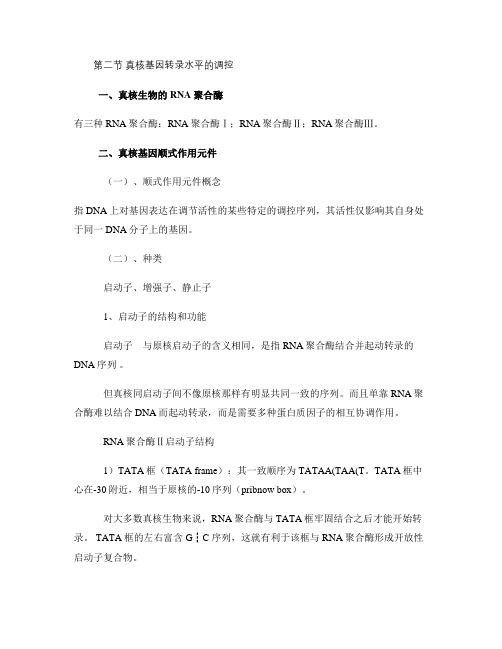
第二节真核基因转录水平的调控一、真核生物的RNA聚合酶有三种RNA聚合酶:RNA聚合酶Ⅰ;RNA聚合酶Ⅱ;RNA聚合酶Ⅲ。
二、真核基因顺式作用元件(一)、顺式作用元件概念指DNA上对基因表达在调节活性的某些特定的调控序列,其活性仅影响其自身处于同一DNA分子上的基因。
(二)、种类启动子、增强子、静止子1、启动子的结构和功能启动子与原核启动子的含义相同,是指RNA聚合酶结合并起动转录的DNA序列。
但真核同启动子间不像原核那样有明显共同一致的序列。
而且单靠RNA聚合酶难以结合DNA而起动转录,而是需要多种蛋白质因子的相互协调作用。
RNA聚合酶Ⅱ启动子结构1)TATA框(TATA frame):其一致顺序为TATAA(TAA(T。
TATA框中心在-30附近,相当于原核的-10序列(pribnow box)。
对大多数真核生物来说,RNA聚合酶与TATA框牢固结合之后才能开始转录。
TATA框的左右富含G┇C 序列,这就有利于该框与RNA聚合酶形成开放性启动子复合物。
2)CAAT框(CAAT frame):位置在-75附近,一致序列为GGC(TCAATCT。
CAAT框可能控制着转录起始的频率。
(3)GC框在-90bp左右的GGGCGG序列称为GC框。
一个在-30—+15即核心启动子(core promoter element,另一为上游启动子区(upstream promoter element在-150—-50,不同物种的启动子因子有显著差异,启动子区没有和mRNA的TATA和CAAT盒顺序,故物种间大前体-rRNA基因的转录起始是不同的。
基因间间隔含一个或几个终止信号可终止其之前的基因的转录而其本身不转录,间隔区含多种反向顺序可作为增强子结合转录因子2、增强子的结构和功能增强子(enhancer):又称为远上游序列(far upstream sequence 。
它是远距离调节启动子以增加转录速率的DNA序列,其增强作用与序列的方向无关,与它在基因的上下游位置无关。
原核生物和真核生物基因表达调控复制、转录、翻译特点的比较

原核生物和真核生物基因表达调控、复制、转录、翻译特点的比较1.相同点:转录起始是基因表达调控的关键环节①结构基因均有调控序列;②表达过程都具有复杂性,表现为多环节;③表达的时空性,表现为不同发育阶段和不同组织器官上的表达的复杂性;2.不同点:①原核基因的表达调控主要包括转录和翻译水平。
真核基因的表达调控主要包括染色质活化、转录、转录后加工、翻译、翻译后加工多个层次。
②原核基因表达调控主要为负调控,真核主要为正调控。
③原核转录不需要转录因子,RNA聚合酶直接结合启动子,由sita因子决定基因表的的特异性,真核基因转录起始需要基础特异两类转录因子,依赖DNA-蛋白质、蛋白质-蛋白质相互作用调控转录激活。
④原核基因表达调控主要采用操纵子模型,转录出多顺反子RNA,实现协调调节;真核基因转录产物为单顺反子RNA,功能相关蛋白的协调表达机制更为复杂。
⑤真核生物基因表达调控的环节主要在转录水平,其次是翻译水平。
原核生物基因以操纵子的形式存在。
转录水平调控涉及到启动子、sita因子与RNA聚合酶结合、阻遏蛋白、负调控、正调控蛋白、倒位蛋白、RNA聚合酶抑制物、衰减子等。
翻译水平的调控涉及SD序列、mRNA的稳定性不稳定(5’端和3’端的发夹结构可保护不被酶水解mRNA的5’端与核糖体结合可明显提高稳定性)、翻译产物及小分子RNA的调控作用。
真核生物基因表达的调控环节较多:在DNA水平上可以通过染色体丢失、基因扩增、基因重排、DNA甲基化、染色体结构改变影响基因表达。
在转录水平主要通过反式作用因子调控转录因子与TA TA盒的结合、RNA聚合酶与转录因子-DNA复合物的结合及转录起始复合物的形成。
在转录后水平主要通过RNA修饰、剪接及mRNA运输的控制来影响基因表达。
在翻译水平有影响起始翻译的阻遏蛋白、5’AUG、5’端非编码区长度、mRNA的稳定性调节及小分子RNA。
真核基因调控中最重要的环节是基因转录,真核生物基因表达需要转录因子、启动子、沉默子和增强子。
第八章 真核基因转录调控(共84张PPT)

但真核基因转录发生在细胞核(线粒体基因的转录 在线粒体内),翻译则多在胞浆,两个过程是分开 的,因此其调控增加了更多的环节和复杂性,转 录后的调控占有了更多的分量。
• (二)真核基因的转录与染色质的结构变化相 关。
❖ ④增强子的作用机理虽然还不明确,但与其他顺 式调控元件一样,必须与特定的蛋白质结合后才 能发挥增强转录的作用。
❖ 增强子一般具有组织或细胞特异性,许多增强子只在 某些细胞或组织中表现活性,是由这些细胞或组织中 具有的特异性蛋白质因子所决定的。
• ①影响模板附近的DNA双螺旋结构,导 致DNA双螺旋弯折或在反式因子的参与 下,以蛋白质之间的相互作用为媒介形 成增强子与启动子之间“成环”连接,活 化基因转录;
• 实验表明这段序列甲基化可使其后的基因不能转录,甲基 化可能阻碍转录因子与DNA特定部位的结合从而影响转录
。
• 如果用基因打靶的方法除去主要的DNA甲基化酶,小鼠的 胚胎就不能正常发育而死亡,可见DNA的甲基化对基因表 达调控是重要的。
• 由此可见,染色质中的基因转录前先要有一个被激活的过程, 但目前对激活机制还缺乏认识。
• 真核启动子一般包括转录起始点及其上游约100- 200bp序列,包含有若干具有独立功能的DNA序列元 件,每个元件约长7-30bp。
• 最常见的哺乳类RNA聚合酶Ⅱ启动子中的元件
哺乳类RNA聚合酶Ⅱ启动子中的元件序列
元件名称 共同序列
名称
结合的蛋白因子 分子量 结合DNA长度
TATAbox TATAAAA
• 三、真核基因转录水平的调控
转录因子的主要功能

转录因子的主要功能:
1.基础转录调控:在真核生物中,转录因子作为一般转录因子(general transcription factors,
GTFs),起到基础转录调控的作用。
2.转录的差异性增强:转录因子可以绑定临近调控基因的DNA增强子区域,从而差异调控各种基
因的表达。
3.参与发育过程:转录因子可以参与到发育过程中。
4.细胞信号的沟通:转录因子可以释放一种可以产生与受体细胞进行信号传导的分子,使细胞之间
可以相互沟通。
5.环境应答:转录因子也能参与环境刺激的信号级联下游。
6.细胞周期调控:一些原癌或肿瘤抑制基因,有助于调节细胞周期,这是转录因子的一个重要功能。
7.发病机制:转录因子可以用于改变宿主细胞的基因表达,促进发病机制。
真核生物基因转录水平的反式调控ppt
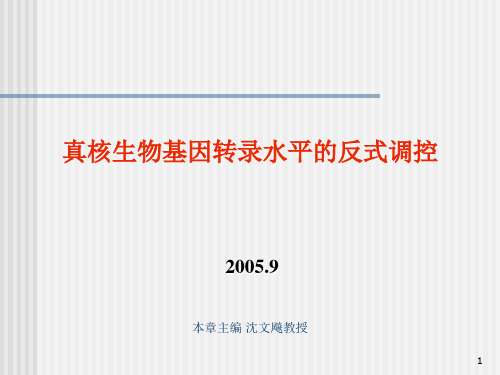
从功能上讲,植物Myb蛋白作为转录因子参与诸如
类黄酮类化合物的生物合成、毛状体发育、分生组织增 殖、GA应答以及干旱胁迫响应等信号转导过程。而编码 植物Myb蛋白的myb相关基因 是一个很大的基因家族, 因此也能调节发育进程以及参与对外界胁迫应答相关基 因的表达。
15
• 有些转录因子同时包含特异与非特异的DNA结合域, 而且后者对于目标基因的转录激活是必需的;
29
阴阳因子-1(Yin Yang-1,YY1)是一类新的转录因 子,它通过与其它蛋白发生互作从而具有转录激活和阻 遏功能,同时YY1也是核基质结合蛋白,其结合基序的 多样性可能是其功能多样性的基础。
由于YY1的结合基序核心是 CCAT、ACAT、TCAT,
其旁侧序列也具有很大的异质性,其结合基序的可变性 很大程度上允许YY1结合和影响一大批基因的转录,而 结合位点的可变性也使 YY1因子结合基序与大量其它因 子的结合基序互相靠近或重叠,从而使转录调控更加严
同,大多数bZIP类因子的亮氨酸拉链通常包含有4个或5
个7单位重复,而在拟南芥的ATB2中则有9个。 另外寡聚化结构域以外区域的差异也会影响到其功
能。
25
细胞核定位信号 真核生物转录因子是选择性的进入细胞核的,因此 转录因子也包含以富含精氨酸和赖氨酸核心肽为特征的
NLS,而碱性核心区的功能也受旁侧残基的影响。转录
• VP1是一种植物基因(包括小麦的Em基因)的转录因
子,含有一个弱的非特异性的DNA结合域-BR2(B2) 和一个序列特异的结合域BR3(B3),能够识别Sph元
件(CATGCATG),而该元件存在于Em以及其它一些
植物基因中。 • 有意思的是,VP1是通过BR2而非BR3来激活Em表达
分别简要阐述原核生物和真核生物转录调控的基本过程

3.分别简要阐述原核生物和真核生物转录调控的基本过程。
原核生物的转录:1.启动RNA聚合酶正确识别DNA模板上的启动子并形成由酶、DNA和核苷三磷酸(NTP)构成的三元起始复合物,转录即自此开始。
第一个核苷三磷酸与第二个核苷三磷酸缩合生成3′-5′磷酸二酯键后,则启动阶段结束,进入延伸阶段。
2. 延伸σ亚基脱离酶分子,留下的核心酶与DNA的结合变松,因而较容易继续往前移动。
核心酶无模板专一性,能转录模板上的任何顺序,包括在转录后加工时待切除的居间顺序。
随着转录不断延伸,DNA双链顺次地被打开,并接受新来的碱基配对,合成新的磷酸二酯键后,核心酶向前移去,已使用过的模板重新关闭起来,恢复原来的双链结构。
3. 终止转录的终止包括停止延伸及释放RNA聚合酶和合成的RNA。
在原核生物基因或操纵子的末端通常有一段终止序列即终止子;RNA合成就在这里终止。
真核生物的转录:真核生物RNA的转录与原核生物RNA的转录过程在总体上基本相同,但是,其过程要复杂得多,主要有以下几点不同。
1. 真核生物RNA的转录是在细胞核内进行的,而蛋白质的合成则是在细胞质内进行的。
所以,RNA转录后首先必须从核内运输到细胞质内,才能指导蛋白质的合成。
2. 真核生物一个mRNA分子一般只含有一个基因,原核生物的一个mRNA分子通常含有多个基因,而除少数较低等真核生物外,一个mRNA分子一般只含有一个基因,编码一条多态链。
3. 真核生物RNA聚合酶较多在原核生物中只有一种RNA聚合酶.4. 真核生物RNA聚合酶不能独立转录RNA对真核生物的转录调控过程叙述过于笼统,该过程要比原核生物的转录调控复杂得多。
书写不认真,有多处标点符号错误!。
真核生物基因表达调控的特点及主要调控环节

真核生物基因表达调控的特点及主要调控环节真核生物基因表达调控是一个复杂而精密的系统,涉及到多种调控机制和调控环节。
通过这些调控机制和环节,真核生物能够在不同的细胞类型和不同的发育阶段中表达特定的基因,从而实现细胞功能的多样化和分化。
下面我们将详细介绍真核生物基因表达调控的特点以及主要调控环节。
首先,真核生物基因表达调控具有高度的精细性和特异性。
在真核生物细胞中,每个细胞都包含着相同的基因组,但不同细胞类型和组织会表达不同的基因。
这种差异性主要是通过转录调控来实现的,即通过对特定基因的转录进行调控,使得只有需要的基因在特定的时间和空间表达。
这种精细性和特异性的调控是真核生物细胞功能多样化和分化的重要基础。
其次,真核生物基因表达调控涉及多种调控机制和调控因子。
在真核生物细胞中,基因表达的调控是一个复杂的过程,需要多种调控机制和调控因子的参与。
其中,转录因子是最为重要的调控因子之一,它们可以结合到基因的启动子区域,促进或抑制该基因的转录。
此外,还有一些非编码RNA、表观遗传学修饰等调控机制也在基因表达调控中扮演着重要角色。
这些调控机制和调控因子相互作用,共同调控着基因的表达。
另外,真核生物基因表达调控还存在着复杂的信号传导网络。
在细胞内部,存在着多种信号通路和信号分子,它们可以感知外界环境的变化,并将这些信息传递给细胞核,从而影响基因的表达。
这些信号传导网络可以通过激活或抑制转录因子的活性,改变基因的表达水平。
通过这种方式,细胞可以根据外界环境的变化做出相应的调整,保持内部稳态。
综上所述,真核生物基因表达调控具有高度的精细性和特异性,涉及多种调控机制和调控因子,以及复杂的信号传导网络。
这些特点和调控环节共同构成了真核生物基因表达调控系统的核心。
通过深入研究这些调控机制和调控环节,可以更好地理解细胞功能的多样化和分化过程,为疾病的治疗和生命科学研究提供重要的理论基础。
真核生物基因的转录调控方式

真核生物基因的转录调控方式细胞中转录调控是真核生物基因表达的重要环节,它能使每个基因起到预期的功能。
真核生物基因的转录调控主要有以下几类:一、前体RNA调控1. 终止核糖体调控。
终止核糖体结合蛋白在前体RNA的3'末端可以抑制RNA启动子的功能,从而阻止mRNA的生成和翻译,实现终止的作用。
2. 内源性核小体调控。
除了内源性核小体对前体RNA的调控,其还和终止核糖体及非终止核糖体形成复合物,在前体mRNA的转录前期,延长mRNA的保留时间,促进表达蛋白的合成。
3. 干扰素调控。
干扰素是一种由 RNA 结构构成的多肽,可以和 mRNA 或其前体结合,实现调控效果,从而对 mRNA 的合成起到调节作用。
二、转录因子调控1. 单钩螺旋蛋白调控。
这类蛋白在细胞内以巨噬细胞因子的形式表现出来,可以直接结合 DNA,起到调控基因组的作用。
2. 二聚体蛋白调控。
二聚体蛋白可以将 DNA 上的高等水平信息转化为转录因子和 DNA 直接相互作用,从而调控基因组的表达。
3. 转录因子激活。
转录因子可以通过多种化学反应产生激活,从而激活该基因的转录和转录调控因子本身的转录,从而调控基因表达。
三、转录起始调控1. 启动子调控。
启动子位于 DNA 前体或基因的 5' 末端,可以与转录因子结合,影响RNA合成和翻译的起始,并调节其强度。
2. 增强子调控。
增强子是RNA调控的另一种重要机制,它可以将转录因子和 DNA 结合,从而促进转录的开始和调节的强度。
3. 转录抑制子调控。
转录抑制子是一种抑制基因表达的调控机制,它可以限制转录启动子的激活,从而达到抑制基因表达的作用。
以上就是真核生物基因转录调控的几类方式。
转录调控在真核生物细胞起到了重要的作用,其不仅可以影响基因的转录,而且还能影响基因表达的开始、中止和转录水平,从而控制机体中蛋白质的数量、形态和功能,对人类健康和疾病的发病机制和治疗具有重要的借鉴意义。
原核生物和真核生物基因表达调控复制、转录、翻译特点的比较
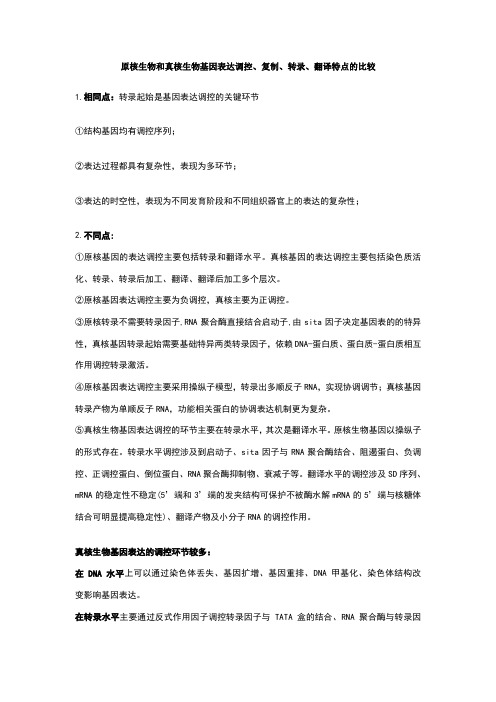
原核生物和真核生物基因表达调控、复制、转录、翻译特点的比较1.相同点:转录起始是基因表达调控的关键环节①结构基因均有调控序列;②表达过程都具有复杂性,表现为多环节;③表达的时空性,表现为不同发育阶段和不同组织器官上的表达的复杂性;2.不同点:①原核基因的表达调控主要包括转录和翻译水平。
真核基因的表达调控主要包括染色质活化、转录、转录后加工、翻译、翻译后加工多个层次。
②原核基因表达调控主要为负调控,真核主要为正调控。
③原核转录不需要转录因子,RNA聚合酶直接结合启动子,由sita因子决定基因表的的特异性,真核基因转录起始需要基础特异两类转录因子,依赖DNA-蛋白质、蛋白质-蛋白质相互作用调控转录激活。
④原核基因表达调控主要采用操纵子模型,转录出多顺反子RNA,实现协调调节;真核基因转录产物为单顺反子RNA,功能相关蛋白的协调表达机制更为复杂。
⑤真核生物基因表达调控的环节主要在转录水平,其次是翻译水平。
原核生物基因以操纵子的形式存在。
转录水平调控涉及到启动子、sita因子与RNA聚合酶结合、阻遏蛋白、负调控、正调控蛋白、倒位蛋白、RNA聚合酶抑制物、衰减子等。
翻译水平的调控涉及SD序列、mRNA的稳定性不稳定(5’端和3’端的发夹结构可保护不被酶水解mRNA的5’端与核糖体结合可明显提高稳定性)、翻译产物及小分子RNA的调控作用。
真核生物基因表达的调控环节较多:在DNA水平上可以通过染色体丢失、基因扩增、基因重排、DNA甲基化、染色体结构改变影响基因表达。
在转录水平主要通过反式作用因子调控转录因子与TATA盒的结合、RNA聚合酶与转录因子-DNA复合物的结合及转录起始复合物的形成。
在转录后水平主要通过RNA修饰、剪接及mRNA运输的控制来影响基因表达。
在翻译水平有影响起始翻译的阻遏蛋白、5’AUG、5’端非编码区长度、mRNA的稳定性调节及小分子RNA。
真核基因调控中最重要的环节是基因转录,真核生物基因表达需要转录因子、启动子、沉默子和增强子。
分子生物学基础第七章真核基因表达的调控第三节真核基因表达转录水平的调控
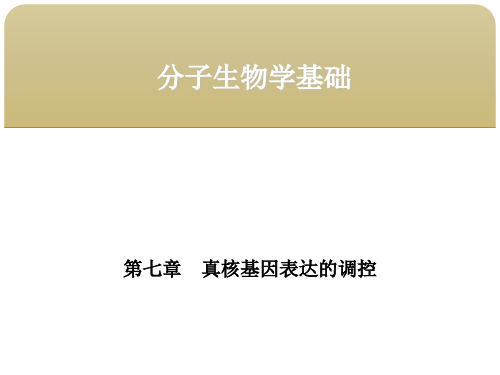
第七章 真核基因表达的调控
第三节 真核基因表达转录水平的调控
一、真核基因转录与染色质结构变化的关系 DNA绝大部分都在细胞核内与组蛋白等结合成染色质, 染色质的结构影响转录,至少有以下现象: 1.染色质结构影响基因转录 在真核细胞中以核小体为基本单位的染色质是真核基 因组DNA的主要存在方式。DNA盘绕组蛋白核心形成核小体, 妨碍了与转录因子及RNA聚合酶的靠近和结合,使基因的 活性受到抑制。 2.组蛋白的作用 组蛋白H1及核心组蛋白共同参与核小体的组装与凝聚。 在特殊氨基酸残基上的乙酰化、甲基化或磷酸化等修饰, 可改变蛋白质分子表面的电荷,影响核小体的结构,从而 调节基因的活性。
第三节 真核基因表达转录水平的调控
图7-6 碱性螺旋-环-螺旋结构图
第三节 真核基因表达转录水平的调控
螺旋-转角-螺旋结构域是最早发现于原核生物中的一个关键因子, 该结构域长约20个aa,主要是两个α-螺旋区和将其隔开的β转角。 其中的一个被称为识别螺旋区,因为它常常带有数个直接与DNA序列 相识别的氨基酸。其结构如图7-3所示。
图7-3 螺旋-转角-螺旋结构及其与 DNA的结合
第三节 真核基因表达转录水平的调控
2.增强子 增强子是指能使基因转录频率明显增加的DNA序列。增强子的作 用有以下特点。 ①增强效应十分明显。一般能使基因转录频率增加10~200倍,有 的可以增加上千倍, ②增强效应与其位置和取向无关。 ③大多为重复序列。 ④增强效应有严密的组织和细胞特异性。说明只有特定的蛋白质 (转录因子)参与才能发挥其功能。 ⑤没有基因专一性,可以在不同的基因组合上表现增强效应。 ⑥许多增强子还受外部信号的调控,如金属硫蛋白的基因启动区 上游所带的增强子,就可以对环境中的锌、镉浓度做出反应。 ⑦增强子要有启动子才能控
- 1、下载文档前请自行甄别文档内容的完整性,平台不提供额外的编辑、内容补充、找答案等附加服务。
- 2、"仅部分预览"的文档,不可在线预览部分如存在完整性等问题,可反馈申请退款(可完整预览的文档不适用该条件!)。
- 3、如文档侵犯您的权益,请联系客服反馈,我们会尽快为您处理(人工客服工作时间:9:00-18:30)。
Regulating Eukaryotic Transcription
25.1 Introduction
expression of Eukaryotic genes might be regulated at any one of several stages:We can distinguish (at least) five potential control points, forming the series: Activation of gene structure Initiation of transcription Processing the transcript Transport to cytoplasm Translation of mRNA激活、起始转录、加工、运 输、翻译 Figure 22.1 Gene expression is controlled principally at the initiation of transcription, and it is rare for the subsequent stages of gene expression to be used to determine whether a gene is expressed, although control of processing may be used to determine which form of a gene is represented in mRNA.
Positive clones confirmed on SD/-Ade/-HisHale Waihona Puke -Leu/-Trp/X-a-Gal
25.5 Response elements are recognized by activators
•
• •
•
A response element is a sequence in a eukaryotic promoter or enhancer that is recognized by a specific transcription factor. The heat shock response element (HSE) is a sequence in a promoter or enhancer that is used to activate a gene by an activator induced by heat shock. The glucocorticoid response element (GRE) is a sequence in a promoter or enhancer that is recognized by the glucocorticoid receptor ,which is activated by glucocorticoid steroids. The serum response element (SRE) is a sequence in a promoter or enhancer that is activated by transcription factor(s) induced by treatment with serum. This activates genes that stimulate cell growth.
25.3 Independent domains bind DNA and activate transcription
Activators and other regulatory proteins require two types of ability: •They recognize specific target sequences located in enhancers, promoters, or other regulatory elements that affect a particular target gene. •Having bound to DNA, an activator exercises its function by binding to other components of the transcription apparatus.
25.3 Independent domains bind DNA and activate transcription
key concepts:
•DNA-binding activity and transcription-activation are carried by independent domains of an activator. •The DNA-binding domain determines specificity for the target promoter or enhancer. •The role of the DNA-binding domain is to bring the transcriptionactivation domain into the vicinity of the promoter.
25.2 There are several types of transcription factors
Initiation of transcription involves many protein-protein interactions among transcription factors bound at the promoter or at an enhancer as well as with RNA polymerase. We can divide the factors required for transcription into several classe: Basal factors, together with RNA polymerase, bind at the startpoint and TATA box. Activators are transcription factors that recognize specific short consensus elements. They bind to sites in the promoter or in enhancers. Another group of factors necessary for efficient transcription do not themselves bind DNA. Coactivators provide a connection between activators and the basal apparatus. Some regulators act to make changes in chromatin.
25.3 Independent domains bind DNA and activate transcription
Figure 25.3 DNA-binding and activating functions in a transcription factor may comprise independent domains of the protein.
25.3 Independent domains bind DNA and activate transcription
The activator GAL4 has a DNA-binding domain that recognizes a UAS, and an activating domain that stimulates initiation at the target promoter. The bacterial repressor LexA has an N-terminal DNAbinding domain that recognizes a specific operator. When LexA binds to this operator, it represses the adjacent promoter. Figure 22.4 The ability of GAL4 to activate transcription is independent of its specificity for binding DNA. When the GAL4 DNA-binding domain is replaced by the LexA DNA-binding domain, the hybrid protein can activate transcription when a LexA operator is placed near a promoter.
Construct pathogen induced yeast twohybrid cDNA library
cDNA library of oilseed rape line RS-1 constructed in yeast
Library Insert size analysis by PCR
Yeast cells that are mating. A zygote typically has three-lobed shape, the lobes representing the two haploid(parental) cells and the budding diploid cells
25.2 There are several types of transcription factors
Figure 22.2 Factors involved in gene expression include RNA polymerase and the basal apparatus, activators that bind directly to DNA at the promoter or at enhancers, co-activators that bind to both activators and the basal apparatus, and regulators that act on chromatin structure.
